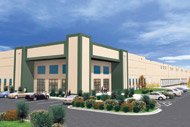|
FEATURE ARTICLE, JULY 2008
Taking the Industrial LEED in the Southeast
 |
DP Partners recently completed LEED-certified building A in LogistiPort at Savannah.
|
|
Some industrial developers in the Southeast are making it a priority to meet environmentally-friendly standards with their projects. They are finding the end result is a mutually beneficial outcome for both the market and the environment.
“Our initiative is to create sustainable developments, which is the right thing to do, and it is also a great marketing tool for prospective tenants,” says Kurt Nelson, SVP and Regional Development Officer for IDI, an Atlanta-based industrial real estate company. IDI recently completed Crossroads Distribution Center Building F, an 800,308-square-foot warehouse and distribution center in Olive Branch, Miss., which is the largest industrial edifice in the Southeast to receive LEED (Leadership in Energy and Environmental Design) certification and also marks the first LEED-certified building for an IDI facility. Also, DP Partners, a Reno, Nev.-based commercial developer, set a benchmark in the Southeast by completing the new, 1 million-square-foot LogistiPort at Savannah, which is the first LEED-registered industrial park in the area. LogistiPort at Savannah, located on the west side of Dean Forest Road, has two speculative facilitaties, 689,400 square feet and 347,280 square feet, built to LEED Silver Certification standards. The LEED program was developed and approved by the United States Green Building Council, or USGBC. LEED is a system of performance criteria meant to enhance the sustainability and energy efficiency of industrial complexes. Developers must meet several goals, which range from roofing to foundation standards, to achieve the coveted LEED certification for their projects. “It makes developers, designers and contractors sit down and decide how to accomplish goals for more sustainable projects,” Nelson says. Reaching LEED Certification imposes teamwork between the different branches of developers, which is a vital component in developing a project that surpasses the extensive standards. Developers have discovered that some of these standards are easier to meet than others. “It is difficult to achieve a 20 to 30 percent overall savings in energy; it requires a lot of coordination,” says James V. Mascaro, developer for the Eastern region for DP Partners. Another hardship that some developers have faced is the area itself. “The most difficult thing is the recycling of waste because there were no companies that provided that service in the area, which was surprising because other markets have companies that do,” Nelson says. In spite of these barriers, some requirements are easier to obtain because the ancillary industries have caught up to current LEED standards. For example, it’s easier now to achieve the criteria for low or no VOC (volatile organic compounds) content for sealants and adhesives because many companies now manufacture safer products than in the past. Possessing LEED certification for an industrial building could potentially be a lure for future tenants, which, along with higher energy efficiency, is an incentive for industrial real estate companies to obtain LEED certification. “It varies, for some [potential tenants] it’s nice but it’s not something really vital for their deal, for some it’s essential,” Nelson says. IDI has several more projects in the pipeline all across the country that are slated to be LEED certified, as well as a 452,715-square-foot LEED certified building in the same industrial park called Crossroads Building A. DP Partners is also continuing its LEED certified development as well, with projects across the Southeast and southern New Jersey. The goal of the USGBC’s LEED program is to increase the sustainability of estates and to improve the well being of the environment as it pertains to energy consumption. These developers have experienced the benefits of LEED and understand its significance. “It’s in the news, green is everywhere,” Mascaro says. “We all have a responsibility to be caretakers, that’s from kindergartners to senior citizens.” — John Nelson
LEEDER BOARD
IDI’s Crossroads Building F’s sustainable qualities include:
1. Reduction of utility usage by a minimum of 20 percent. Annual savings of $0.08 to $0.10 per square foot can be achieved.
2.White TPO (thermoplastic olefin) roofing lowers warehouse temperatures by 10 to 15 degrees in summer.
3. Irrigation and plumbing design reducing water consumption by over 50 percent.
4. Low-emitting adhesives, sealants and coatings for improved air quality and health.
5. A waste-recycling program, which diverted 50 percent of construction waste to recycling facilities during building construction. |
©2008 France Publications, Inc. Duplication
or reproduction of this article not permitted without authorization
from France Publications, Inc. For information on reprints
of this article contact Barbara
Sherer at (630) 554-6054.
|
